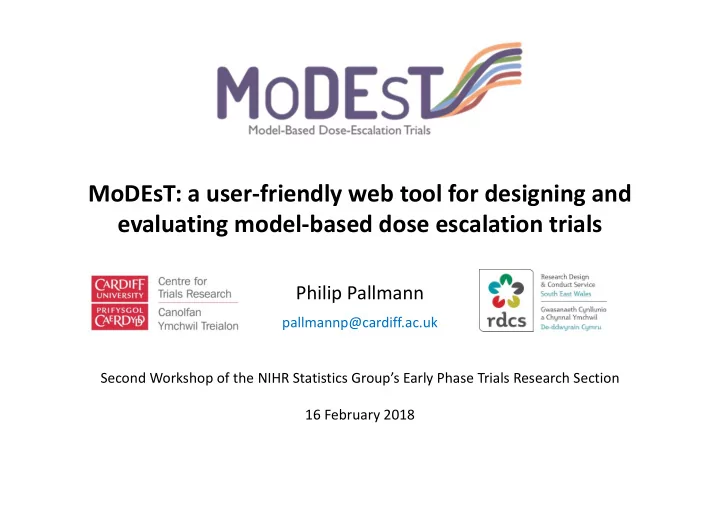

MoDEsT: a user-friendly web tool for designing and evaluating model-based dose escalation trials Philip Pallmann pallmannp@cardiff.ac.uk Second Workshop of the NIHR Statistics Group’s Early Phase Trials Research Section 16 February 2018
This work was funded by MRC Network of Hubs for Trials Methodology Research project grants N78 and B1. http://www.network-hubs.org.uk/research/network-projects Joint work with: Fang Wan (Lancaster University, Lancaster) Christina Yap (CRUK Clinical Trials Unit, Birmingham) Adrian P. Mander (MRC Biostatistics Unit, Cambridge) Graham M. Wheeler (CRUK & UCL Cancer Trial Centre, London) Sally Clive (Edinburgh Cancer Centre, Edinburgh) Thomas Jaki (Lancaster University, Lancaster) Lisa V. Hampson (Novartis, Basel)
http://modest.lancs.ac.uk Also available as package modest (Pallmann & Wan 2017)
“Design” module
“Conduct” module
Bayesian decision procedure 1) Logistic model 2) Priors 3) Gain function 4) Escalation and stopping rules
1) Logistic regression model log odds intercept slope
2) Priors for dose-toxicity model Difficult: priors for β 0 and β 1 Less difficult: priors for two doses 1. assume probability P A of a DLT at dose A, “worth” x A pseudo-observations 2. assume probability P B of a DLT at dose B, “worth” x B pseudo-observations Example: assume 5% DLTs at 1.5 mg/kg and 50% DLTs at 10 mg/kg, each “worth” 3 observations
3) Gain function Which dose to recommend for the next cohort? Patient gain: choose the dose currently thought to be closest to the target toxicity level optimal from a patient’s perspective Variance gain: choose the dose that will likely maximise the learning about the dose-toxicity relationship optimal from an investigator’s perspective
4) Escalation and stopping rules When escalating: • always start at the lowest dose • do not skip over any doses when escalating • do not escalate upon observing a toxicity in the current cohort Recommend stopping when: • the maximum number of patients has been reached • a pre-defined maximum number of consecutive patients have received the same dose • a sufficiently accurate estimate of the MTD has been obtained • no dose among those in the pre-specified set is deemed safe
Quercetin data example Phase I dose-escalation study in cancer patients suffering from a variety of forms of solid tumour no longer amenable to standard therapies (Ferry et al. 1996) • 9 dose levels • max. 18 cohorts of size 3 • 20% risk of renal toxicity (WHO grade ≥ 2) acceptable • aim: find MTD • 3+3 design (kind of)
Quercetin data example Phase I dose-escalation study in cancer patients suffering from a variety of forms of solid tumour no longer amenable to standard therapies (Ferry et al. 1996) • 9 dose levels • max. 18 cohorts of size 3 • 20% risk of renal toxicity (WHO grade ≥ 2) acceptable • aim: find MTD • 3+3 design (kind of)
Literature Ferry DR, Smith A, Malkhandi J, Fyfe DW, deTakats PG, Anderson D, Baker J, Kerr DJ (1996) Phase I clinical trial of the flavonoid quercetin: pharmacokinetics and evidence for in vivo tyrosine kinase inhibition. Clinical Cancer Research , 2 (4), 659-668. Pallmann P, Wang F (2017) modest : Model-based dose-escalation trials. R package version 0.3-1. http://cran.r-project.org/package=modest Whitehead J, Brunier H (1995) Bayesian decision procedures for dose determining experiments. Statistics in Medicine , 14 (9), 885-893. Whitehead J, Williamson D (1998) Bayesian decision procedures based on logistic regression models for dose-finding studies. Journal of Biopharmaceutical Statistics , 8 (3), 445-467. Zhou Y, Whitehead J (2003) Practical implementation of Bayesian dose- escalation procedures. Drug Information Journal , 37 (1), 45-59.
Recommend
More recommend